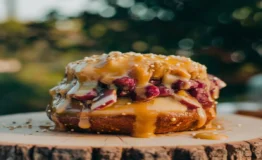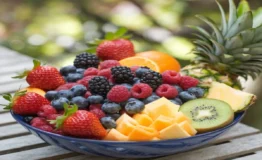Joy Wilson, known as Joy the Baker, loves using browned butter in cookies. She got the idea from her dad’s special chocolate chip cookies. These used a butter-flavored oil. She found that brown butter itself adds a deep flavor.
Her famous Brown Butter Chocolate Chip Cookies with Pecans use softened and browned butter. This makes the cookies moist and rich with a nutty taste. It also helps the cookies get a nice texture without losing their softness.
Adding browned butter gives cookies a caramel-like flavor. They have crisp edges and soft centers. This makes eating them a luxurious experience. The cookies are sweet but also complex.
The browned butter also changes the cookie’s texture. It creates a mix of textures in each bite. This adds to the cookie’s appeal with its nutty smells and toffee flavors.
Key Takeaways
- Browning butter for cookies can add a rich, gourmet cookie flavor.
- Joy Wilson popularized the use of browned butter in cookie recipes.
- Browned butter interacts with the Maillard reaction to enhance flavor complexity.
- Cookies with browned butter have crisp edges and chewy centers.
- The nutty and caramel notes from browned butter elevate the cookie’s overall sensory appeal.
Introduction to Browned Butter
Browned butter, or beurre noisette, has become a hit in the baking world. This technique turns simple butter into a gourmet delight. It’s now popular among bakers and chefs. Learning about brown butter baking is key for those wanting to improve their cooking.
What is Browned Butter?
Browned butter, or beurre noisette, happens when butter melts and the milk solids caramelize. This creates a rich, nutty taste similar to hazelnuts. The change from regular butter to this golden treat is both simple and significant, greatly affecting the final dish.
Why Brown Butter is a Baking Trend
The beurre noisette trend shows how a classic method can change modern baking. Browned butter adds a nutty and aromatic flavor to cookies, cakes, and pastries. It’s part of the gourmet baking movement, making simple recipes into gourmet dishes. By mastering brown butter baking, both new and experienced bakers can discover new tastes and textures.
The Science Behind Browned Butter
Learning about browned butter’s impact on baking involves some culinary science. This process changes regular butter into a flavor powerhouse. It’s all thanks to a chemical reaction.
The Maillard Reaction Explained
The Maillard reaction is key to brown butter chemistry. It happens when butter’s milk solids heat up and caramelize. As the water evaporates, sugars and proteins react, making new flavor compounds.
This Maillard reaction baking gives butter a nutty, toasty smell and a medium amber color.
Impact on Flavor Profile
The Maillard reaction also changes the taste of baked goods. It adds nutty, rich, and caramel flavors. These flavors make baked goods taste deeper than with regular butter.
This flavor enhancement is why many choose browned butter for their baking. The science behind it shows how culinary science and great flavor come together.
How Brown Butter Affects Cookie Texture
Browned butter changes how cookies turn out. It helps bakers get the texture they want. Whether you like cookies with crisp edges or soft centers, browned butter can make them perfect.
Creating Crisp Edges
When you brown the butter in cookie recipes, you get crisp edge cookies. This makes the cookies dry a bit, which changes their texture. They become crispy on the outside.
Experts at King Arthur’s kitchen say this doesn’t affect the cookie’s spread or height. But it makes them crunchier.
Contributing to Chewy Centers
Browned butter also makes chewy center cookies. When butter browns, it changes the milk solids. This adds flavor and changes the cookie’s texture.
These cookies are crispy on the outside and chewy inside. They have a great mix of texture and taste.
Flavor Enhancements: Nutty and Caramel Notes
Browned butter adds a magical touch to cookies, bringing out nutty flavors and caramel-like tastes. This happens because of the chemical changes during the browning process. These changes add a depth and richness that turns a simple cookie into a gourmet delight.
The Magic of Nutty Aromas
When butter browns, it releases nutty flavors that take cookies to a new level. The milk solids in the butter toast, creating a unique nutty aroma. This aroma adds complexity to the taste, making gourmet cookies stand out.
Adding Caramelized Depth
Browning butter also brings caramel notes to cookies. As the butter browns, it develops caramel-like flavors that deepen the sweetness. These caramel notes make each bite rich and indulgent.
Step-by-Step: How to Brown Butter
Browning butter is a detailed process. It starts with picking the right ingredients and getting them ready. Let’s go through each step to make sure you get it right.
Preparation and Ingredients
First, you need high-quality unsalted butter. Cut the butter into even pieces for even melting. This step is key to making brown butter well.
Melting and Browning Process
Next, you start the browning process. Put the butter in a light-colored pan and melt it over medium-low heat. As it melts, it will foam and sizzle, showing the water is evaporating.
Keep cooking and stirring. Watch for the butter to turn clear and amber, with a nutty smell. This means it’s time to take it off the heat to prevent it from burning.
Common Pitfalls and How to Avoid Them
Many people overheat the butter, making it burnt. To prevent this, keep an eye on the color and sounds. Also, remember that browning lowers the butter’s water content. You might need to add more liquid to your recipe.
It’s important to use the browned butter as is—solid, softened, or melted. This ensures your baked goods turn out great.
What Does Browned Butter Do to Cookies?
Adding browned butter to cookie recipes changes their taste and texture. It gives them a bold, toasty flavor that makes baking more enjoyable. This method adds a rich depth to the cookie dough, making it more complex.
Bold, Toasty Flavor
Browned butter is known for its unique toasty taste that blends well with cookies. It creates a deep flavor, often likened to nuts or caramel. This flavor, developed through the Maillard reaction, boosts the cookies’ natural sweetness, turning each bite into a treat.
Enhanced Cookie Dough Performance
Using browned butter also improves the cookie dough. By browning some of the butter, the dough stays moist. This balance prevents the dough from drying out and adds the desired browned butter taste. The cookies end up with a crunchy outside and a soft, chewy inside, making them better in texture.
Recipe Adaptations and Variations
Browned butter can easily be added to any cookie recipe. This lets bakers make classic cookies new again or try out fresh flavor mixes. It’s a great way to get creative in the kitchen, changing cookie sizes and adding different mix-ins. The unique nutty taste of brown butter adds something special.
Using Brown Butter in Classic Recipes
For fans of traditional cookies, brown butter adds a special touch. It makes cookies like chocolate chip or oatmeal even better. The rich, nutty flavor improves the taste and ensures the cookies are both crispy and chewy.
Creating New Flavor Combos
Brown butter lets you explore new tastes in baking. Try it with sea salt or mix it with matcha or lavender. These unique brown butter recipes turn simple cookies into something exciting. They challenge traditional baking and delight those who love to try new things.
Tips from Expert Bakers
When it comes to expert baking tips, few shine as brightly as Joy Wilson and the King Arthur team. They share their deep knowledge and experience to improve cookie recipes with browned butter.
Joy Wilson’s Insights
Joy Wilson is known for her creativity and precision in baking. She suggests mixing browned butter with regular butter for a richer taste. By adjusting the recipe, she makes the classic chocolate chip cookie even better. Her careful and creative methods have won her many fans.
Professional Techniques from King Arthur’s Kitchen
The King Arthur team focuses on precise and tested methods. They stress the need for the right balance of moisture and flavor when using browned butter. Their advice helps make your cookies gourmet, with a rich taste and perfect texture.
Conclusion
Baking with browned butter changes the game, adding deep, rich flavors to cookies. This method brings out nutty, toasty, and caramelized tastes. These flavors make traditional cookies much better.
We’ve learned how browned butter combines science and art in baking. By understanding the Maillard reaction and how to brown butter right, you can make gourmet cookies. These cookies taste new and fancy, even with simple recipes.
Learning from experts like Joy Wilson and King Arthur Baking helps you get better at making browned butter cookies. This knowledge lets you try new things and improve your baking. In short, using browned butter in baking is a great way to make your cookies taste gourmet. It makes baking fun and rewarding, giving you tasty results every time.
Tips from Expert Bakers
What does browned butter do to cookies?
Browning butter for cookies makes them taste gourmet. It adds a nutty, caramel-like flavor. This process, called the Maillard reaction, makes the cookies richer and more complex.
What is Browned Butter?
Browned butter, or beurre noisette, is butter that has been melted and cooked until it turns brown. This creates a nutty and rich flavor loved in gourmet baking.
Why Brown Butter is a Baking Trend
Brown butter baking is popular because it turns simple recipes into gourmet treats. It adds depth, unique flavors, and complexity. Both home bakers and professionals love it.
The Maillard Reaction Explained
The Maillard reaction happens when butter is browned. It causes the butter to lose water and turn the milk solids brown. This process creates the nutty aroma and rich flavor of browned butter.
Impact on Flavor Profile
The Maillard reaction changes the flavor of baked goods. It adds nutty, rich, and caramel notes. This makes cookies taste nuanced and complex.
Creating Crisp Edges
Browned butter makes cookies crisp on the edges. The less water in the dough improves the texture at the edges.
Contributing to Chewy Centers
Browned butter keeps the centers chewy. It balances the moisture with rich, buttery flavor. This enhances the cookie’s texture.
The Magic of Nutty Aromas
Browned butter adds a magical nutty aroma to cookies. It reminds you of toasted nuts, making the flavor better.
Adding Caramelized Depth
The browning process gives cookies a caramelized depth. This adds rich, toffee-like flavors. It makes the sweetness and complexity of the cookies better.
Preparation and Ingredients
Start by cutting the butter into even pieces for melting. Use unsalted butter for better flavor control in your recipe.
Melting and Browning Process
Melt the butter over medium-low heat. Watch for it to clear and foam. When the milk solids turn golden brown and smell nutty, it’s done.
Common Pitfalls and How to Avoid Them
Don’t overheat the butter, as it can burn. Keep an eye on the color change. Remove from heat when it reaches a medium amber hue and smells nutty.
Bold, Toasty Flavor
Browned butter gives cookies a bold, toasty flavor. This makes each bite rich and indulgent, enhancing the taste.
Enhanced Cookie Dough Performance
Partially browning the butter improves the dough. It has balanced moisture and a unique flavor. This makes the dough better to work with.
Using Brown Butter in Classic Recipes
Adding browned butter to classic cookie recipes, like chocolate chip, enriches the flavor. It doesn’t change the cookie’s structure.
Creating New Flavor Combos
Browned butter lets bakers try new flavors. By mixing different nuts, spices, and chocolates, you can create unique taste combinations.
Joy Wilson’s Insights
Joy Wilson recommends mixing softened browned butter with some unbrowned butter. This keeps the dough together while adding flavor depth.
Professional Techniques from King Arthur’s Kitchen
King Arthur’s Kitchen suggests keeping the moisture balanced. Add browned butter carefully for the best gourmet results.






